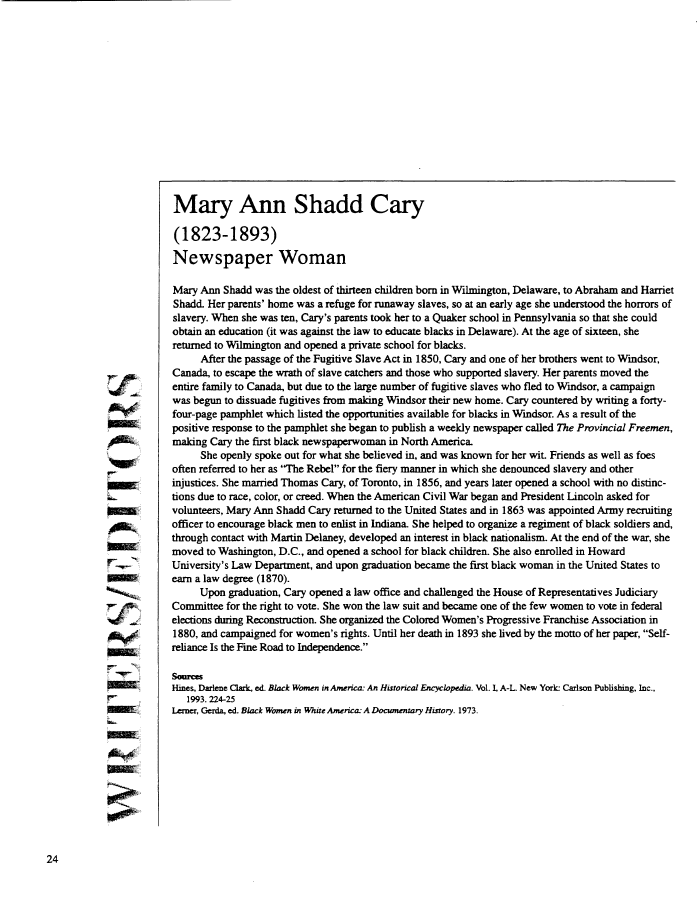 |
||||
|
TASK FORCE TO STUDY THE HISTORY AND LEGACY OF SLAVERY IN MARYLAND (Final Report) 1999/12/31 MdHR 991422 MdHR 991422, Image No: 384 Print image (75K) |
 |
||||
|
TASK FORCE TO STUDY THE HISTORY AND LEGACY OF SLAVERY IN MARYLAND (Final Report) 1999/12/31 MdHR 991422 MdHR 991422, Image No: 384 Print image (75K) |
| Mary Ann Shadd Gary (1823-1893) Newspaper Woman Mary Ann Shadd was the oldest of thirteen children born in Wilmington, Delaware, to Abraham and Harriet Shadd. Her parents' home was a refuge for runaway slaves, so at an early age she understood the horrors of slavery. When she was ten, Gary's parents took her to a Quaker school in Pennsylvania so that she could obtain an education (it was against the law to educate blacks in Delaware). At the age of sixteen, she returned to Wilmington and opened a private school for blacks. After the passage of the Fugitive Slave Act in 1850, Gary and one of her brothers went to Windsor, Canada, to escape the wrath of slave catchers and those who supported slavery. Her parents moved the entire family to Canada, but due to the large number of fugitive slaves who fled to Windsor, a campaign was begun to dissuade fugitives from making Windsor their new home. Gary countered by writing a forty-four-page pamphlet which listed the opportunities available for blacks in Windsor. As a result of the positive response to the pamphlet she began to publish a weekly newspaper called The Provincial Freemen, making Gary the first black newspaperwoman in North America. She openly spoke out for what she believed in, and was known for her wit. Friends as well as foes often referred to her as "The Rebel" for the fiery manner in which she denounced slavery and other injustices. She married Thomas Gary, of Toronto, in 1856, and years later opened a school with no distinctions due to race, color, or creed. When the American Civil War began and President Lincoln asked for volunteers, Mary Ann Shadd Gary returned to the United States and in 1863 was appointed Army recruiting officer to encourage black men to enlist in Indiana. She helped to organize a regiment of black soldiers and, through contact with Martin Delaney, developed an interest in black nationalism. At the end of the war, she moved to Washington, D.C., and opened a school for black children. She also enrolled in Howard University's Law Department, and upon graduation became the first black woman in the United States to earn a law degree (1870). Upon graduation, Gary opened a law office and challenged the House of Representatives Judiciary Committee for the right to vote. She won the law suit and became one of the few women to vote in federal elections during Reconstruction. She organized the Colored Women's Progressive Franchise Association in 1880, and campaigned for women's rights. Until her death in 1893 she lived by the motto of her paper, "Self-reliance Is the Fine Road to Independence." Sources Hints, Darlene Clark, ed. Black Women in America: An Historical Encyclopedia. Vol. I, A-L. New York: Carlson Publishing, Inc., 1993. 224-25 Lemer, Gerda, ed. Black Women in White America: A Documentary History. 1973. 24 |